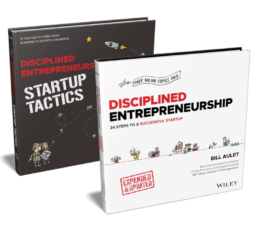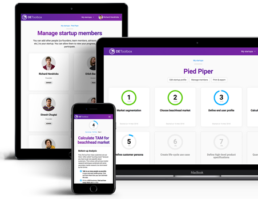Last month as things started to wind down for the holidays and lecturing in classes slowed down, I had the exciting opportunity to host the CFOs from Zoom, Peloton, and Grubhub at the MIT CFO Summit and the CFO Leadership Council Conferences. This was a great chance to talk directly with leaders in some of the real rocket ships in this COVID crisis. These are three poster examples of companies who have seen effectively managed the dramatic market shifts to more digitalization as was highlighted on the front page of The Wall Street Journal at the same time.
Let me summarize six key lessons learned from analyzing what made them so successful:
- Understanding how technological capabilities are changing.
All saw the possibilities from the evolving technological advancements but that was necessary but wholly insufficient on its own. - Understanding changing consumer behavior patterns.
Just because something is possible, does not mean customers will adopt it. You need to understand customer habits and if they are open to change, which generally they are not… unless… - Building an organization with the capability to realize this opportunity.
The companies vision is that something will be possible and it will be adopted by customers over time. The question is “When?”. You have to put yourself in a position to capitalize on the changing trends in #1 and #2 above but not bet on a specific time. It usually takes much longer than it seems it logically should (in B2C and B2B). Put yourself in a position to capitalize with a strong organization and resources but not too many resources that you lose your muscles to listen to customers very carefully. Creating new markets and changing customer buying habits is very hard and takes time. You can’t just listen to what customers say they want in terms of product, you have to understand their *real* underlying problem and continually validate that you can address it even if their embrace of your efforts is not as complete and as widespread as you would like. Believe in the vision of what these trends are telling you but do not get ahead of yourself in counting on customer adoption faster than they are willing to accept. Push the frontier with a market segment (your beachhead market) but also have patience. - Recognizing a window of opportunity when it comes.
Sometimes, luck will fall your way, and there will be something to disrupt the status quo. These often represent outstanding opportunities to change behavior and habits for the better. You must recognize them immediately and capitalize on them. We talk extensively about this in Step 13A in the Disciplined Entrepreneurship Workbook. Realize this is your time and you must invest to take advantage of this finite window and if you miss it, your investments in customer acquisition afterward will likely be at best much less efficient and likely a waste of resources. You must seize the moment. - Moving fast—clock speed is critical.
The speed with which you can iterate with customers once you get the opportunity in this window is critical. One of my favorite quotes is from Thomas Edison who said something to the effect that the measure of innovation is how many times one can iterate on a new idea within 24 hours. You have this golden, perishable opportunity and you have to deliver, be responsive, and win their trust. Be humble, hungry, and even more hardworking during this unique time. - Being data-driven:
In his book That Will Never Work, Marc Randolph talks about how “nobody knows anything.” All we can bring to the discussion to start is a well-reasoned hypothesis but we need to then test it with data. Great companies like Netflix, Amazon, Google, and others use data religiously to tell if the hypothesis is right (or what we call Step #23 “show the dogs will eat the dog food”). Peloton, Zoom, and Grubhub, not surprisingly, also strongly embrace this approach.
Now that I have given you the lead, let me explain how I got there and dive a bit deeper. (It should be noted that Marius Ursache is the editor of this website and when I first sent him my blog post, he wisely suggested that I not “bury the lead.” Maybe I am getting more academic without even noticing so I rewrote to bring the six points to the top.)
I agreed to moderate the fireside chats/interviews because I was interested to see firsthand if they had seen the opportunity coming and intentionally prepared in a way that would be instructive to others. I was also anxious to see what they did they separated them from their competitors. Lastly, I was interested in any other lessons to be learned that could be translated to other situations on how to be more “resilient plus” (the new term for “antifragile”).
On the first point, for all three companies, they saw the megatrends changing in their favor but even so were caught by surprise by how it was all dramatically accelerated by the pandemic. Weren’t we all! They had no special insight at the micro-level. They were all however completely committed to the future of dramatically more digitization so they had a head start for sure. So the answer to the first question above is that they did not succeed because they had brilliant insight with regard to a crisis like this happening, it just happened to support their existing thesis. Like everyone else, they were caught off guard.
Secondly, what separated them from their competitors seems clear to me was their attention to the data signals and the clock speed with which they adjusted. It was also very reassuring to see that they all did so with empathy. By this I mean, they were not trying to profiteer but really thought hard about the impact it was having on their customers and broader society. Zoom made its platform available for free to over 100K schools very quickly. Grubhub thought deeply about the ramifications on their restaurant owners as well as the consumers and made the conscious decision to forego short-term profits to help the communities deal with their very deep and serious challenges.
It should be noted that all of these companies had sufficient resources – cash on the balance sheet – to think longer-term which is a luxury but one earned by disciplined execution. This had put them in a place where they were not vulnerable or fragile to sudden challenges. Very smart and not an accident. It should also be noted that they did not have so much money – see WeWork as the grossly extreme case of this – that they had lost their discipline. They were financially frugal but also had built a buffer so they could be resilient. This kept them hungry, humble, and in touch with the market place.
What was strikingly clear in talking to all of these companies is that they were not some sort of super visionary led companies with a Steve Jobs-like character at the top talking about dramatic changes that no one else was seeing yet, they were driven by data. The most important data was with regard to customer engagement and adoption by market segment. They also noted that dramatic changes in CAC/CoCA as well. In the heat of this crisis, the story of success on these gold standards of excellence is not some special crystal ball or insights by a futuristic guru making big risky bets, it was about understanding the market place and adapting quickly.
A great example of this was Zoom and security. While sales were taking off for this company early on, there were competitors chomping at the bit to take them down. Product and service shortcomings were certain to be exposed and highlighted by analysts and competitors. The newfound spotlight created more scrutiny than they had ever had before. There were features and usability shortfalls that needed to be taken care of and Zoom did an outstanding job addressing these rapidly.
The existential threat came with the security challenge. Starting in April, the media questioned with great intensity and great specificity the security of Zoom and it was not clear if Zoom was going to survive this valid question. The company responded with speed and force not by attacking the messenger but by addressing the problem. They made security a top priority and systematically came out with new features (including buying a security company) at a pace unimaginable just a few years (if not last year). While the issue has not gone away and should not, it is no longer the proverbial Sword of Damocles dominating every conversation about Zoom. Honesty in reading the market, willingness to acknowledge weaknesses, speed to address and disciplined execution are what have kept Zoom on top.
So this is how I got to the six lessons above in the lead. Knowing the principles above and executing them successfully, no matter if the crisis is COVID or anything else, is good counsel to help make you and your organization more “resilient+” (the “artist” formerly known as antifragile).
The author
Bill Aulet
A longtime successful entrepreneur, Bill is the Managing Director of the Martin Trust Center for MIT Entrepreneurship and Professor of the Practice at the MIT Sloan School of Management. He is changing the way entrepreneurship is understood, taught, and practiced around the world.

The Disciplined Entrepreneurship Toolbox
Stay ahead by using the 24 steps together with your team, mentors, and investors.
The books
This methodology with 24 steps and 15 tactics was created at MIT to help you translate your technology or idea into innovative new products. The books were designed for first-time and repeat entrepreneurs so that they can build great ventures.

How relevant was this article to you?
Click on a star to rate it!
Average rating 4.3 / 5. Vote count: 12
No votes so far! Be the first to rate this post.
We are sorry that this article was not useful for you!
Let us improve this post!
Tell us how we can improve this post?
